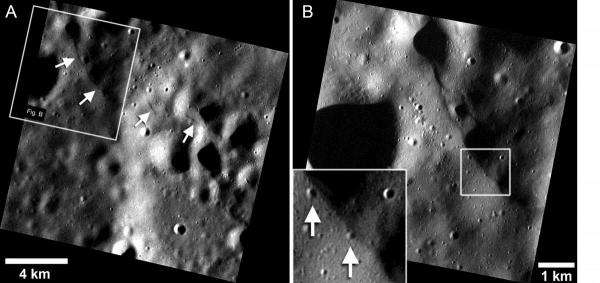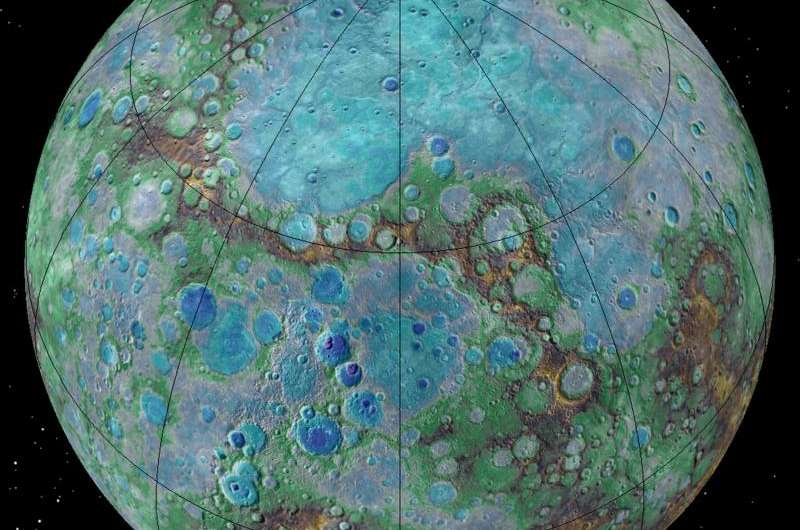A. A cluster of small lobate scarp thrust faults on Mercury’s intercrater plains (~38.90° N, 27.93° E). The longest scarp in the cluster (upper arrows) is ~4.3 km in length. (MESSENGER Mercury Dual Imaging System (MDIS) image frame number EN1029769395M). B. Close up view of small scarp shown in A. Inset: A small impact crater ~90m in diameter (lower arrow) is potentially disturbed or crosscut (note the lack of a well-defined rim on the scarp face) by the scarp segment, and another crater ~135m in diameter (upper arrow) may be horizontally shortened. The box in B shows the location of the inset. Figure modified from Watters et al., 2016. Credit: Paul Scherrer Institute
Images acquired by NASA's MErcury Surface, Space ENvironment, GEochemistry, and Ranging (MESSENGER) spacecraft show geologic features that indicate Mercury is likely still contracting today, joining Earth as a tectonically active planet in our Solar System.
Previously undetected small fault scarps were observed in images collected during the MESSENGER mission's final 18 months in orbit around Mercury, according to a new paper in Nature Geoscience. During these last months of the mission, the spacecraft's altitude was lowered allowing the surface to be imaged at higher resolutions than ever before possible.
Planetary Science Institute Research Scientist Maria Banks is a co-author on "Recent tectonic activity on Mercury revealed by small thrust fault scarps." Smithsonian Senior Scientist Thomas R. Watters is lead author and Principal Investigator of the research.
"These small-scale thrust fault scarps are orders of magnitude smaller, only a few kilometers in length and tens of meters of relief, than larger scarps previously known to exist on the surface of Mercury," said Banks, who analyzed MESSENGER images to find and analyze these small-scale tectonic structures. "Steady meteoroid bombardment quickly degrades and destroys structures this small, indicating that they must have formed relatively recently. They are comparable in size to very young fault scarps identified on the lunar surface attributed to shrinking of the Moon."
Fault scarps appear as cliff-like landforms. Larger, older scarps were identified in both MESSENGER and Mariner 10 images and are evidence of the global contraction of Mercury as it's interior cooled causing the crust to shrink.
"The young age of the small scarps means that Mercury joins Earth as a tectonically active planet in our Solar System, with new faults likely forming today as Mercury's interior continues to cool." said Watters, of the Center for Earth and Planetary Studies at the National Air and Space Museum.
Credit: NASA/JHUAPL/Carnegie Institution of Washington/USGS/Arizona State University
Active faulting, paired with evidence for ancient faulting and also the recent discovery by PSI Senior Scientist Catherine Johnson that Mercury's global magnetic field was present billions of years ago, offer consistent support for long-lived slow cooling of Mercury's still hot outer core.
Slip along thrust faults associated with small lunar scarps is possibly connected with shallow moonquakes detected by seismometers deployed during the Apollo missions. Some of these moonquakes reached magnitudes of near 5 on the Richter scale. Seismometers deployed on Mercury in future missions would likely detect Mercury-quakes associated with ongoing slip events on small faults and reactivated older large faults.
More information: [25] Recent tectonic activity on Mercury revealed by small thrust fault scarps, Nature Geoscience, nature.com/articles/doi:10.1038/ngeo2814
Journal information: Nature Geoscience
Provided by Paul Scherrer Institute
























